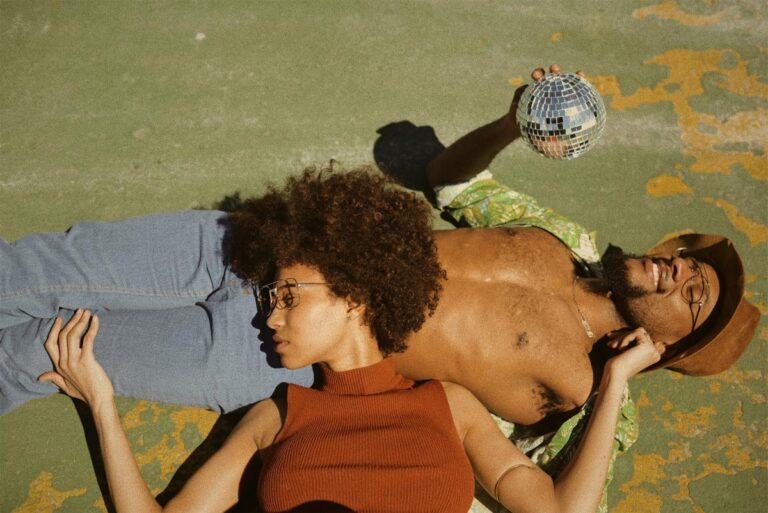Why have 70s-inspired designs gained popularity recently?
What do Jia Tolentino’s Trick Mirror cover, Chobani yoghurt packaging, and the comforter startup Buffy’s logo all have in common? The answer is poofy, curvy, 70s-inspired typography. The 20th century style has reemerged as we enter this next decade, infiltrating seemingly everything from corporate branding to freelance artwork. So, why have the 70s come back now?
Design, in its myriad forms, is cyclical. More often than not, it’s a reaction to what came directly before it in terms of style and ideology. This recent influx of inflated letters reflects this ebb and flow within the field. In contrast to the affinity for sleek minimalism in the 2010s—think Outdoor Voices’ Signature Tote—the 2020s have reintroduced a sense of community through 70s-inspired designs. Cooper Hewitt design curator, Ellen Lupton, wrote that by 2009, after a flashy entrance into the new millennium, fonts and branding had calmed down to evoke “a sense of order and sobriety.” The 2010s championed polished, spaced letters that reflected the rapid technological and digital growth of the period. During this time, looking computer-generated was preferred.
In the late 2010s and now in the early 2020s, however, this has changed. The distance mirrored by the typography of the last decade has been replaced by a closeness and familiarity evoked by fonts such as Simula, Cheltenham, and Chobani Serif, (the last of which was created specifically for the yoghurt company). This intimacy within the more rounded letters can be attributed to the handwritten quality of the typefaces, or a reaction against the often rigid predictability of computer-generated designs. Simula, for instance, was created by artist and designer Justin Sloane. The final characters that are used today are the result of four years of drawing and redrawing by Sloane, the attention to detail yet human quality of which is seen in every stroke.
Rather than the digital look of minimalist fonts, these trendy 70s-inspired typefaces have a handcrafted—or hand-drawn—look to them. This aligns with the current, predominant movement back to appreciating the local and the handmade (or at least the aesthetics of it). At a time when large corporations and tech startups loom heavily in our zeitgeist, consumers seem drawn to the appearance of the unique, which is often associated with the handmade rather than mass-produced. This is mirrored by the skyrocketing popularity of preloved and deadstock Y2k Cop Copine and Custo Barcelona tops on Depop. Buyers want something that’s one-of-a-kind and has a story behind it, in contrast to enormous, tentacular companies that pump out more of the same.
Connected to these romantic notions of responsible consumerism is an increasing awareness of Mother Earth. Notably, the first Earth Day took place on 22 April, 1970. The typography surrounding the growth of this holiday became a defining aesthetic of the movement; these fonts became symbolic of an appreciation and fight for nature. Today, as we grow more and more conscious of the impact we have on the Earth—and as the sentiment has infiltrated the mainstream, think IKEA’s latest TV ad—a revival of the thoughts and feelings surrounding the first Earth Day have reemerged. By aligning a brand’s aesthetic with these ideas through 70s-inspired typography, they visually appeal to certain demographics—largely millennials and gen Zers. Effectively, in some cases, companies are able to announce their support of sustainability without actually having to make a statement as a brand. The shapes of the letters speak loud enough for them.
Even though social media and online shopping are still prominent now more than ever, consumers are pining for products that feel more analogue rather than algorithmically generated and easily able to fit into a grid. The movement towards fonts that feature bubbly, full characters reflects these societal attitude shifts and ideas looming largely on our collective mind, or subconscious. Their curved, bloated edges seem to press up against or move outside the lines of our rectangular screens or square social media platforms.
However, Natasha Jen, partner at the design firm Pentagram and creator of Buffy’s logotype, sees the rise in popularity of these designs differently. Rather than mirroring the “multi-voice, multi-identity, highly inclusive moment” that these 70s fonts and their diverse shapes represent, the resurgence of these designs has led to “quite the opposite thing, because everything starts to look the same.”
Despite symbolically opposing the minimalist typography that dominated the 2010s, these puffy fonts continue to demonstrate how much of what we see on and offline is influenced by algorithms. The homogeneity expressed between the Chobani yoghurt packing, the Buffy logo, and more instead reflects how social media reductively condenses new ideas into one, easily marketable visual grounded in familiarity. Much like the sleek, Silicon-Valley-esque fonts they seem to visually withstand, they actually are representative of widespread, profitable trends. But, unlike the 2010s, instead of virtue signalling in Aperçu or Gill Sans, brands now do so in Bookman and ITC Clearface.





